Paraganglioma – Predictors factors of major aggressivity
Keywords:
paraganglioma, succinate dehydrogenase mutation, metastatic disease, prognosisAbstract
Paragangliomas are rare neuroendocrine tumors whose clinic and presentation depend on secretory profile, size, and location. About 40% of paragangliomas are associated with genetic syndromes with the succinate dehydrogenase enzyme complex (SDH) mutation being the most frequent. Mutation in SDHB is associated with a worse prognosis and increased risk of metastatic disease. We present a clinical case of a 45-year-old man, with a germline mutation in the SDHB gene, who initially underwent excision of paraganglioma with 10 cm that recurred with disseminated disease. He underwent several systemic treatments with some response but unfortunately died in the context of oncologic disease. Regarding this case, we review some predictors of poor prognosis.
Downloads
References
Angelousi A, Kassi E, Zografos G, Kaltsas G. Metastatic pheochromocytoma and paraganglioma. Eur J Clin Invest. 2015 Sep. 45(9):986-97. doi: 10.1111/eci.12495.
Cavenagh T, Patel J, Nakhla N, Elstob A, Ingram M, Barber B, et al. Succinate dehydrogenase mutations: paraganglioma imaging and at-risk population screening. Clin Radiol. 2019 Mar;74(3):169-177. doi: 10.1016/j.crad.2018.11.004.
Strauss D, Correa A, Gong Y, Karachristos A, Kutikov A. Management of SHDB positive patient with metastatic bilateral giant retroperitoneal paragangliomas. Urol Case Rep. 2021 Nov 26; 40:101950. doi: 10.101/j.eucr.2021.101950.
Rich T, Jackson M, Roman-Gonzalez A, Shah K, Cote G, Jimenez C. Metastatic sympathetic paraganglioma in a patient with loss of the SDHC gene. Fam Cancer. 2015 Dec;14(4):615-9. doi: 10.1007/s10689-015-9821-0.
Palha A, Cortez Luísa. Paragangliomas: Diagnóstico, Tratamento e Seguimento. Rev Port Endocrinol Diabetes Metab. 2017;12(2):215-222.
Turkova H, Prodanov T, Maly M, Martucci V, Adams K, Widimsky J, et al. Characteristics and outcomes of metastatic SDHB and sporadic pheochromocytoma/paraganglioma: an national institutes of health study. Endocr Pract. 2016 Mar;22(3):302-14. doi: 10.4158/EP15725.OR
Garcia-Carbonero R, Teresa F, Mercader-Cidoncha E, Mitjavila-Casanovas M, Robledo M, Tena I, et al. Multidisciplinary practice guidelines for the diagnosis, genetic counseling and treatment of pheochromocytomas and paragangliomas. Clin Transl Oncol. 2021 Oct;23(10):1995-2019. doi: 10.1007/s12094-021-02622-9
Hadoux J, Favier J, Scoazec J, Leboulleux S, Ghuzlan A, Caramella C, et al. SDHB mutations are associated with response to temozolomide in patients with metastatic pheochromocytoma or paraganglioma. Int J Cancer. 2014 Dec 1;135(11):2711-20. doi: 10.1002/ijc.28913
Hubalewska-Dydejczyk A, Trofimiuk M, Sowa-Staszczak A, Gilis-Januszewska A, Wierzchowski W, Pach D, Budzyński A, et al. [Somatostatin receptors expression (SSTR1-SSTR5) in pheochromocytomas].Przegl Lek. 2008;65(9):405-7.
Saveanu A, Muresan M, Micco C, Taieb D, Germanetti A, Sebag F, et al. Expression of somatostatin receptors, dopamine D₂ receptors, noradrenaline transporters, and vesicular monoamine transporters in 52 pheochromocytomas and paragangliomas. Endocr Relat Cancer. 2011 Mar 21; 18:287.
Helder W, Hofland L. Somatostatin receptors in pheochromocytoma. Front Horm Res. 2004;31:145-54. doi: 10.1159/000074662.
Mundschenk J, Unger N, Schulz S, Höllt V, Schulz S, Steinke R, Lehnert H, et al. Somatostatin receptor subtypes in human pheochromocytoma: subcellular expression pattern and functional relevance for octreotide scintigraphy. J Clin Endocrinol Metab. 2003 Nov;88(11):5150-7. doi: 10.1210/jc.2003-030262.
Cecchin D, Schiavi F, Fanti S, Favero M, Manara R, Fassina A, et al. Peptide receptor radionuclide therapy in a case of multiple spinal canal and cranial paragangliomas. J Clin Oncol. 2011 Mar 1;29(7):e171-4. doi: 10.1200/JCO.2010.31.7131.
Essen M, Krenning E, Kooij P, Bakker W, Feelders A, Herder W, et al. Effects of therapy with [177Lu-DOTA0, Tyr3]octreotate in patients with paraganglioma, meningioma, small cell lung carcinoma, and melanoma. J Nucl Med. 2006 Oct;47(10):1599-606.
Garkavij M, Nickel M, Sjögreen-Gleisner K, Ljungberg M, Ohlsson T, Wingårdh K, et al. 177Lu-[DOTA0,Tyr3] octreotate therapy in patients with disseminated neuroendocrine tumors: Analysis of dosimetry with impact on future therapeutic strategy. Cancer. 2010 Feb 15;116(4 Suppl):1084-92. doi: 10.1002/cncr.24796.
Forrer F, Riedweg I, Maecke HR, Mueller-Brand J. Radiolabeled DOTATOC in patients with advanced paraganglioma and pheochromocytoma. Q J Nucl Med Mol Imaging. 2008 Dec;52(4):334-40.
Nozières C, Walter T, Joly M, Giraud S, Scoazec J, Borson-Chazot F, et al. A SDHB malignant paraganglioma with dramatic response to temozolomide-capecitabine. Eur J Endocrinol. 2012 Jun;166(6):1107-11. doi: 10.1530/EJE-11-1098.










